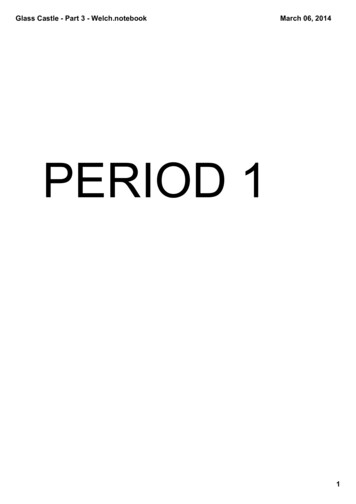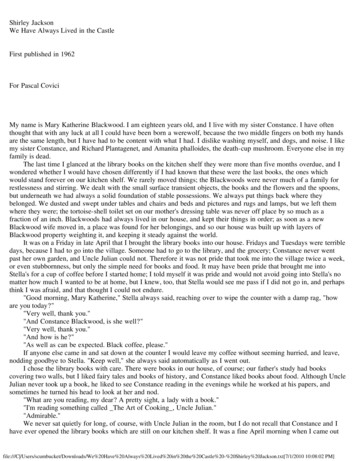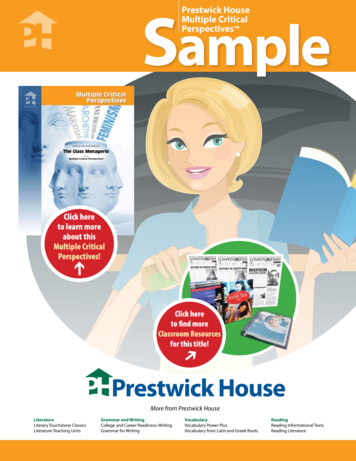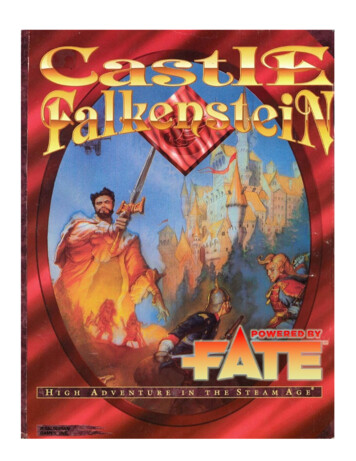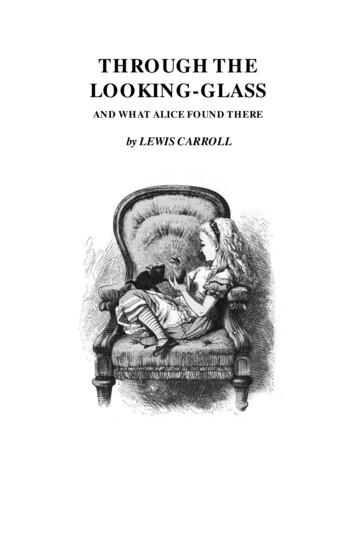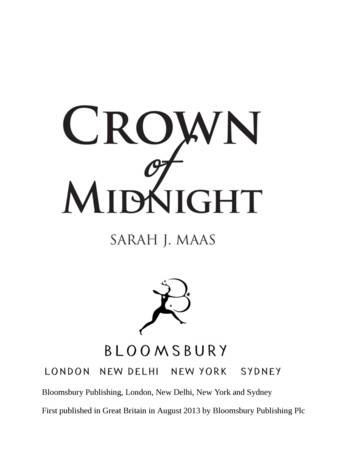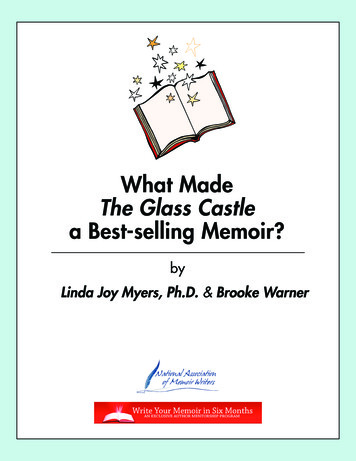
Transcription
What MadeThe Glass Castlea Best-selling Memoir?Linda Joy Myers, Ph.D. & Brooke Warner
The Formulaic Memoir: What Made The Glass Castle a BestsellerLinda Joy Myers & Brooke Warnerwww.writeyourmemoirinsixmonths.comWeek One: Memory & Writing Dark TruthsBrooke Warner: Welcome to class tonight—class number one of what made The Glass Castle abestseller. Tonight’s class is memory and writing dark truths. I’m Brooke Warner and I’m here withLinda Joy Myers. Hi, Linda Joy.Linda Joy Myers: Hi, Brooke. Great to be here with all of you.BW: We are absolutely thrilled by the turnout for this four-week class, which clearly speaks to howbeloved a book this is, and also to how much people feel that they’re writing through issues that maybefeel similar to what Jeannette Walls did. We’re going to talk about a lot of that tonight in writing memoryand dark truths. We want to start by introducing ourselves. Many of you know us already, but we do havea few new people. We’ll start with you, Linda Joy.LJM: Thank you, Brooke. I’m a memoirist and I’ve also been a therapist for many years. I’m thepresident of the National Association of Memoir Writers. I’m the author of the memoir Don’t Call MeMother and two books on how to write memoir, The Power of Memoir and The Journey of Memoir. I willadd that the memoir Don’t Call Me Mother is a finalist in the Foreword Book Review book of the yearcontest.BW: Congratulations. That is something to be jazzed about, for sure. I’m Brooke Warner, publisher atShe Writes Press and the founder of Warner Coaching. My book is What’s Your Book? I also have an ebook called How to Sell Your Memoir. More than anything, both of us are incredibly passionate aboutmemoir. We partner well together and we have lots of good synergy. We love teaching these best-sellingmemoir courses. This is our third best-selling memoir class.The format of these classes is that we do about forty minutes of teaching, alternating and conversing. Andwe do want to hear from you. It is interactive; we will stop and address questions and comments wherethey’re relevant and/or if they’re not, we’re not ignoring you. We might just think that something is a bittoo big and so we’ll take it on at the end. You can just go ahead and put your questions in the questionwindow, and if you want to do a quick practice and say hi or do a shout-out, please do. Linda Joy is going
to kick us off just by telling us a little bit about the context for why we’re starting with memory andwriting dark truths.LJM: As all of you know that have read the book—and if you haven’t read it, you’ve heard about thestory that Jeannette Walls tells about her family, which is going through quite a few very, very difficultscenarios in her family. It is a book about trauma—emotional trauma—and some people see it through thelens of being a book about alcoholism and mental illness. It depends on your perspective on that. That’sall in the subtext for the book. She doesn’t come right out and label anything, which is a skill, and we willbe talking about some of the skills that Jeannette Walls used to make The Glass Castle so amazing. Andreally, the book is about the emotional truth of what she experienced.We’re going to be showing you today some of the tools that help people write about trauma andemotional truth and some of the ways that you can balance the dark and the light in your writing whenyou’re writing a dark story or writing about something very emotionally traumatizing that happened toyou. So we’ll be doing that through the whole four weeks, teaching you about these things.BW: I want to encourage you to pull out your books because I am going to be referencing specific scenesin this class today and specific page numbers. It gives some context about what is unique about JeannetteWalls’ book. There are a number of things that are unique; I think one of the most unique things is that insome ways, this is a story that resonates so broadly because many, many people come out ofdysfunctional family situations and many people want to write their stories, and yet Jeannette Walls’book, for whatever reason, rose above and succeeded on this massive level. It of course is a verycompelling story—a kind of story that you almost can’t turn away from—so there’s that on the one hand.Her stories are punctuated by things that are both troubling and delightful, which makes for an interestingblend, and your experience as a reader is a bit of a roller coaster with her.There’s fierce loyalty, on the one hand, and severe dysfunction on the other. I think a lot of people canrelate to that within the context of their own families, even if their own trauma is more or less severe. Italk to people all the time who will say something to me like, “The Glass Castle resonates with me but mystory is more traumatic than that. My story is much worse than that in some ways.” That feels hard,because The Glass Castle is put up as an example of a very traumatic memoir and so you might feelhindered by that. We certainly don’t want you to feel hindered by that. It’s okay if your story is moretraumatic, because there are some ways in which Jeannette’s book—it’s traumatic, but it’s also a story ofsurvival. She is in such good spirits throughout the whole thing, mostly. I’m going to be talking about thispassion later, but to start with I’m going to be talking about scenes.LJM: I agree with you, Brooke. We both see that so many people are coming to writing a memoir fromthe desire to sort out their story or find a new perspective or to heal or to—I’ll talk more about it later, butI call it witnessing yourself in your story. That is part of what Jeannette does and we’ll show you how shedoes some of that in the course.BW: To talk about the scenes and the ways in which Jeannette specifically handles her scenes—in thefree call which some of you attended and listened to, we talked about this idea that she poses her scenesas vignettes. Not always—I want to be clear about that—but many of the scenes are vignettes. I lookedthis up online just to be really clear about what the difference is between a scene and a vignette, andLinda Joy gives a good definition of scene so I might ask you for that. A vignette is a brief, evocativedescription, account, or episode, while a scene is a place or an incident occurs or a sequence ofcontinuous actions. I think it’s an interesting thing to look at, because this idea of a brief, evocativedescription, account, or episode is totally what Jeannette Walls does throughout her book. It’s justpunctuated. I made a note when I was reading; I said, these chapters are loaded with memories. They arepeppered throughout. I like that description, because they are peppered. It has this sort of feeling of
there’s this, there’s this, there’s this. There are small scenes and they’re strung together and we talkedabout this idea that in some ways, they’re interlocking vignettes rather than continuous scenes, which Ifound easy to read. It certainly is fast-paced. But I wanted to give some examples, and it starts very early.Even if you just look at page one, which is, on my version of the paperback, page 9, here she says, “I wason fire. It’s my earliest memory.” This scene—if you look at the early pages of this book, the line breaksare very distinct. You’ll see hard returns, and then we move into a next scene. “When we got to thehospital, nurses put me on a stretcher. They talked in loud, worried whispers while they cut off what wasleft of my fancy pink dress.” Then there’s another hard line break, and then here she is after the fact. “Thedoctors said I was lucky to be alive.” So she’s already taken us through the skin graft in this scene. Itmoves very fast, but it also is told as a sequence of little memories and in essence, they’re vignettes andthey truly do read like childhood memories. On page 11, after the line break, she says, “Every couple ofdays, the nurses change the bandages. They would put the used bandage off to the side, wadded andcovered with smears of blood and yellow stuff and little pieces of burned skin.” What’s compelling aboutthe way that she writes here is that you feel that you are in this child perspective of her experience. She’ssupposed to be three years old here. I mentioned in the free call that that seemed a bit young to me, butnevertheless, you are in a very young perspective and her observations are very childlike. And the waythat the story is told is more as memory. This is what this little section is called, “Writing Scene asMemories.” In fact, the entire vignette—the entire scene—is posed as a memory. She opens and says, “Iwas on fire. It’s my earliest memory.” That’s very powerful, and not very many writers feel that they havethe permission to talk about their experiences as memories. They feel that they need to be in the scene.We largely teach that that’s true, but I also think it’s important to give yourself the flexibility to refer tocertain elements of what you’re recalling, particularly if you’re doing coming of age and you’re writingfrom a young perspective, this is a memory that I have. It takes on a little bit of a different kind ofemotional energy when you contextualize something as a memory. You don’t want to overkill it, butcertainly you can think about it in that way and it’s powerful. Do you want to add something, Linda Joy?LJM: I did. I love that you’re talking about context here from the very beginning—“It’s my earliestmemory. I was three years old.” But it’s interesting that she’s also writing in the past tense, which meanswhile she’s in the character inside the child’s body and mind, she’s also reflecting back at the same time,which is a pretty interesting thing. It’s like conducting a symphony; you’re hearing two levels of melodyall at once.BW: Absolutely. And it is skillful—that’s the thing. It feels young in some ways, but she’s also verymuch intentionally being in this voice of innocence. We have a whole call on the voice of innocenceversus the voice of experience, so that’s going to be an interesting class and we’ll get some more detailsthere. I want to cover a couple of more examples of scenes that she does and what I mean by vignette. Onpage 52 of the trade paperback, this is the piano scene that a lot of you will probably remember when theytry to lift the piano through the house and basically it just crashes right out the back door and lands in thetrees. It’s almost surreal, the way that this happens. The mother is so incredibly irresponsible and doesn’ttake any ownership for what happens. The whole scene is very short—it’s pages 52 and 53—and it is thistiny, encapsulated, contained scene that packs a really strong punch. If you think about the emotionalimpact of what happens when this piano is lifted out and over and then she eventually just starts playingthe piano outside at the end of this chapter. It says, “On the days Mom felt inspired, she took her sheetmusic and one of our school chairs outside and pounded at her music back there. Most pianists never getthe chance to play in the great outdoors, she said, and now the whole neighborhood can enjoy the musictoo.” So what you often see Jeannette doing in her book is making light, in some ways—I don’t mean thatin a negative way at all—but making light of really awful situations by showing the ways in which hermother, who definitely, I would argue, is manic-depressive, is sort of delighted by things that happen nomatter if they’re good or bad. They don’t seem to ascribe much energy, negative or positive, per se. Themom is just very positive throughout—whether that’s merited or not—is what I’m trying to say. What Iwanted to point out is how short of a scene that is and how much she gets done in that little tiny scene.
And then by contrast—I’m going to end on this example—at the end of the book—part four, I believe—which is the part where she’s an adult and in New York, I think, in my opinion, that this entire section is alittle bit too crammed for my taste. It’s possible that this book could have ended when she was 17 at theend of part three, although I think that it’s important to see what happens to her mom and dad as theymove to New York later in life. In some ways, it could have been handled in an epilogue, because theeffect of what happens in the New York section, in my opinion, is that everything moves so fast that I hada bit of a hard time catching up. I felt that I was on fast-forward, and it’s short. It’s only from page 245 to288, and she covers a lot of ground. Some of you might have just appreciated that for the chance to catchup, but the point that I wanted to make is that these scenes do move really fast and they’re—in someways, she’s trying to pack so much in that it didn’t have the same impact as some of the earlier comingof-age stuff where she allowed us to be more in her experiences. I just wanted to point out to all of youthe difference. There’s something to be said here around pacing. The pacing in part four is different thanthe rest of the book, and that may have been intentional—I’m not sure. But it’s important to understandthese concepts for yourself when you’re writing your own scenes.LJM: I’m glad you mentioned that, because I was very surprised, particularly the first time I read it, tosee so much crammed in at the end. Clearly, she wanted to—we were, very briefly, for two pages or three,with the adult Jeannette watching her mother dig in the garbage at the beginning, so she does bring it backto that. If I had to guess, since we work with a lot of memoir writers, most people need to write it straightthrough and figure out where they are and what happened when. She might have pulled some threads tocreate this—in a way, it’s a frame of the now narrator and then the child is the whole story until part four,which is 43 pages. But I have seen it in other books. I saw it in one of Jennifer Lauck’s books, where itwas the child in the very first book and then her second book was half the child and then half a mucholder person with a completely different voice, which I thought was interesting. We can say, oh, that’sgreat or that’s not great—it’s not about that. It’s just that you make these choices when you’re writing.It’s very comforting to know that all the book people say no book or no work of art is without any kind offlaw or what somebody could call a flaw, but all it is is that every artist does what they can to create thework in their own way, the best they can.BW: There are lots of different factors that go into it as well. There are editorial decisions that aremade—Donna is making an interesting point where she says, “I saw part four as an epilogue, so its beingshort didn’t bother me.” That’s kind of cool. That could have been intentional. And then Karen is alsosaying in the comments, “Don’t you think she was trying to redeem her parents in some way in NewYork?” Perhaps redemption and perhaps just because readers would have wanted to know what happened.It was so outrageous, in certain ways, that I’m sure the editor who read this book said, you can’t leave ithere. I might have said that myself—this is not a satisfactory ending. That is a decision that might havejust been made in an editorial capacity.LJM: We do want to know, are you okay? Who are you now? Because a memoir is about identity. It’sabout many things, but part of what it’s about is identity and survival. Certainly in a book like this,particularly since it’s about surviving this—that’s the point.BW: On the theme of survival—that’s a good segue—can you see my slides okay? I just want to makesure.LJM: I can, yes. I like these little bits of film—it’s a very good way of showing what we’re trying to dohere, with these little squares of film. That’s what we’re writing in these scenes. Just a little bit ofbackground about trauma. There’s so much to say about it; we’ll do our best to talk about it this week andthroughout the weeks and weave it through. But to acknowledge that this is what a lot of people need towrite about and want to write about for so many reasons. I’ve been teaching writing to therapists andother people who are interested in writing as healing as a topic for—I guess it’s all the way up to
seventeen years at this point. There is a process that people need to go through from remembering tofiguring out what they want to say. We’re going to take you through some of that in this course—findingthe insignificant moments. But there are some cautions as well. When you write trauma, you need to bebalanced in how you dig in and go into the archaeological dig of traumatic memory. Again, it’s such ahuge topic. There are whole books on traumatic memory and healing trauma that can be helpful to you.But the thing of it is you go into that dark night carefully and you bring a light and you bring a buddy.You bring your dog or Gandalf or somebody like that. You need to go in carefully and with awarenessthat you’re going to run into some tough stuff, but you also in the middle of all that writing and exploringfind amazing gifts. This is why people do it even though it’s tough. The gifts have to do withtransformational moments or insights that come through the writing. When we write, we—as you allperhaps have experienced—we don’t know what is going to come out. That’s both a little scary and alittle exciting—that’s part of the creative energy that happens. When we don’t know what’s going tocome out, we could just be stuck in our inner critic or our fear and not write, but we invite you to writeanyway. Write into these moments. I’ll say how to balance it in just a second. Write into it and see howyou come out of the scene. You may have an epiphany that you have never had before. This happens sooften that I can say that it will happen to you. It may not happen in every scene and every time, but it willhappen. The writing digs past our conscious mind. One of the keys is to write in scene. When we write inscene, like Brooke is talking about, we’re in a certain place at a certain time with the weather, the place,where we are, what is happening, how old we are, who’s around us—either your characters that are inyour story—think of scene as a stage play and who’s on that stage at that moment and where are theylocated. From there—as you know, in all stage plays, in every scene there is a reason for that scene to beoccurring. Why are these people there and what are they up to? As a reader and as a watcher of plays,you’re going, okay, why are we here? Why are we watching this? That helps guide you. When you’rewriting a scene, there’s a reason for it. Every single scene or scenette or vignette—whatever it is thatJeannette Walls is presenting—is there because it shows a particular thing that is happening to her or tothe family. You can see it. I think that’s why it’s hard to put down, is that you’re right there—you’re rightin the middle of it.BW: I want to just interject to say that’s an important question to ask yourself when you’re writing.Oftentimes writers are not asking themselves that relatively easy question: Why is this here? InJeannette’s book, every single scene propels forward something. It’s showing you—even if it’s justshowing dysfunction, in part that is its point. Or showing the fierce loyalty of the family—there are all ofthese places where it’s building upon one another so that you’re getting the essence of her experience. Butit’s important, whatever kind of book that you guys might be writing, to make sure that your scene isserving a purpose.LJM: That’s great—very important. So there are a couple of things about this scene—deepening intoscene, I call it. There are two points of attention. There is the—let’s say you’re five years old like she is.And Jeannette does this in her scene. She is the little girl—she is in that little girl body and that little girlperspective, but you can also see how she’s writing it from the perspective of who she is as an author. Sheis looking down and over the situation that she’s finding herself in. One example is—in the middle of it,on page 59, she’s talking about finding beautiful rocks out in the desert. So I’m just going to read briefly,because I just want to say something about this: “I could not bear the idea of leaving the rocks out there,so I started a collection. We found garnets and granite and obsidian and Mexican crazy lace and more andmore turquoise. We made necklaces for Mom out of the turquoise and we found sheets of mica you couldpound into powder and rub all over your body so you’d shimmer under the Nevada sun as if you werecoated with diamonds.” That is one of the positive moments in the story, and notice how specific she is—what kinds of rocks. Some people would say, we went to the desert and we found a bunch of cool rocks.But Jeannette tells you what the rocks are, what they did with them, and even adds a little bit of magic—“as if we were coated with diamonds.” Again, it’s an example—the narrator child is always trying to finda positive perspective and the author, who is noticing the whole story as she’s writing it, is able to give
you all of those details—to look them up in case she forgot. Maybe she didn’t remember exactly whichrocks, but then maybe she looked up and did her research on what kind of rocks were in that desert. Youcan find that information. She does that so skillfully that you feel like you’re there with her. You need toclaim your experience in the “I” voice. We get a lot of questions—“Can I write it in third person?” I’ll saythis about that: some people have such traumatic scenes that they’re afraid to write it in the “I” voice. It’sjust too much for them. So when you start off, when you’re just doing your healing draft—your very firstmoments of getting something on the page—you can write it in third person. You can say “she” or “he,”knowing that later, once you’re not as shaky about all that, you’ll most likely change it to “I.” Now, thereis experimental work done and you’ll see all kinds of memoirs that you’ll see written in “you,” you’ll seeit written in “we,” you’ll see it written in third person. I think for beginners, that gets to be problematic. Irecommend your early drafts be as early as you can get them into the “I,” because when you say “I,”you’re also powerfully claiming your experience and that is part of the gift that you get from writing amemoir. The final bit here is keeping track of the dark scenes—the moments that are most painful ordifficult. I suggest people make a list of five or ten of your difficult, traumatic, challenging scenes, andthen I want you to write a list of ten—or more, if you can—better moments. They might not be kickinglyhappy, but better moments. They might be moments of joy or moments of redemption or moments whensomeone was kind, moments when you got a gift, or maybe you rubbed mica on your skin and you lookedlike you were bathed in diamonds like Jeannette was talking about. There are these moments in the bookwhere we go, oh, thank you, there’s some relief from some of the other moments that are hard on us toread. Was it hard on you to read some of this, Brooke?BW: Yeah, definitely. I had my moments, and also I think there were a lot of moments of just, I can’tbelieve this is happening, and not in a way of oh my God I don’t believe her, but like oh my God I can’tbelieve this, because you see the ways in which—the things she was subjected to that didn’t feel fair ordidn’t feel okay. Then she has this sort of I would say magical way of making you feel okay about it ormaking it feel like she was almost special because of it. That’s also very skillful because that’s exactlywhat her parents were doing to her.LJM: They were teaching her through that lens. When you write trauma—I’ve had this happen—twothings would happen in my classes when I was teaching before Brooke and I were teaching together.People would say, “I can’t remember things.” That was one thing that would happen and we’re going totalk more about this later, about memory and how to remember better. Or they would say, “I don’t haveany good moments,” or they would say, “Every time I try to write a good moment I fall into the traumaticmoment and I can’t get out.” That’s why I recommend lists. The therapist part of me knows that whenthere’s trauma, you need to have some structure and you need to have a way out. A list is a verystructured thing; you’re not freewriting. You’re not just letting it all hang out. You’re not letting thewriting fall out the end of your pen, because sometimes when that happens you end up in that hole thatyou can’t get out of. Give yourself permission to not do that in case that happens to you. For others of youwho feel more stuck, maybe free writing is a good idea. It helps you get some stuff out so you can seewhat you’re thinking or see what is there. But at all times, do find balance. When you keep your writingtrauma at only fifteen minutes—keep it short, keep it contained, and take good care of yourself.BW: Good advice. People are making good comments, and we’ll get to some of those—the biggerquestions at the end, so thanks everyone. I want to talk here about what it means to write dispassionatelyand why it’s important in a book like this—this is a good segue, because Donna just said in thecomments, “The magical side of her parents was what made it bearable for her and us, I think.” I wouldagree and I would say that the dispassion, in some ways, is what makes it bearable. Jeannette does notwallow in her experiences. In fact, it’s quite the opposite. Sometimes she really makes fun out ofexperiences that are not so fun. You can see that. So it is a very intentional handling that she’s doingwhen she is showing—I think there’s a way in which she’s showing her parents’ approach to the worldand the ways in which that is metabolized in her and how, then, her outlook was impacted by that so that
you’re seeing this whole family that has a very unique and different take on the world and you’restruggling as the reader to figure out what your own feelings are about it. Do you feel happy for them? Doyou feel sorry for them? I didn’t feel sorry for her almost ever. There were a couple of moments that I justthought, Man, that’s tough. Certainly one of those moments is when she finally clues in to how difficultthings are for her mom—when her mother leaves on a trip and she’s left to deal with her father and toallocate his allowance and to deal with him asking her for money. We finally get into her recognition ofhow hard her mom had it. There are just these few moments that are handled almost as moments ofrecognition on Jeannette’s part, like oh wow, this is how I make sense of this. That was really powerful.But there are many moments—and I’m going to read some of them—that show dispassion. And to definedispassion, it means literally not influenced by strong emotion; able to be rational and impartial. There isa question in traumatic memoir, how does one remain rational and impartial? It’s certainly not easy, and Iread a lot of memoir—especially proposals—in my time at Seal Press where the writer is just hitting youover the head with resentment and anger and frustration and they haven’t done the work to becomedispassionate. That’s why I say that it’s important. Memoir is not a therapy session. You need a lot oftherapy sessions to get to a place to be able to write with dispassion, but if you are writing from a place ofbeing triggered, the reader isn’t ready to be in that experience yet. I think that’s one of the things that’s sosuccessful about The Glass Castle and why we can emulate it as a memoir that works, because this trulyis a traumatic memoir and yet you don’t leave the experience feeling traumatized. That is due todispassion and just her showing—like Linda Joy is talking about, too, the upsides and the downsides.There are, in fact, some positive memories here. But some of the positive memories are problematic. Iwant to share one of them, which is the lion scene where they go to the zoo. And what happens is—it’s onpage 106 of the trade paperback, halfway through the page it begins: “One day we heard on the radio thata woman in the suburbs had seen a mountain lion behind her house and had called the police, who shotthe animal. Dad got so angry he put his fist through a wall. ‘That mountain lion had as much right to hislife as that sour old biddy has to hers,’ he said. You can’t kill something just because it’s wild.” This setsoff his determination to go with his children to the zoo and to the lion’s den. He actually takes them insidethe lion’s den; they climb over the chain and when she looks back—this is now on page 109—“When Ilooked back, the cheetah was following us along the side of the cage. And then out comes the man in theblue uniform, running toward us holding onto the gun and nightstick in his belt.” It’s very dramatic. “Hegrabbed Dad by the shoulder, but Dad pushed him off and assumed a fighting stance.” Now, when theyleave—this is the very end of the chapter—“Dad nodded and held out his hand in a peace gesture. He ledus through the crowd and toward the exit, chuckling and shaking his head to let us kids know that thesefools were not worth the time it would take to kick their butts. I could hear people around us whisperingabout the crazy drunk man and his dirty little urchin children, but who cared what they thought? None ofthem had ever had their hand licked by a cheetah.” I love this scene. I think it’s phenomenally written,because it is an example of dispassionate writing. What she shows you very clearly is that her dad wasvery drunk, that he was incredibly irresponsible, and that the impact that they as a family had on otherpeople was not a good one—that people were shaking their heads and saying, look at that drunk guy andthose dirty urchins, and they essentially got kicked out of the zoo. But the bravado of the dad and theexperience of her is a little bit Don Quixote-ish. Like, here we go, we’re going to challeng
The Glass Castle a Best-selling Memoir? The Formulaic Memoir: What Made The Glass Castle a Bestseller . be talking about some of the skills that Jeannette Walls used to make The Glass Castle so amazing. And really, the b
